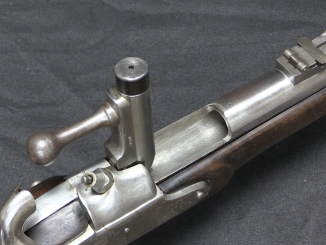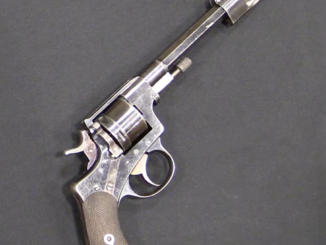The military of Luxembourg chose to purchase Nagant revolvers in the 1880s, and they got three different models. The most interesting of these was the Model 1884 for the Gendarmerie, which was chambered for the black powder 9.4x22mm cartridge and fitted with a long barrel so it could mount a tiny little spike bayonet. Curiously, the Army purchases were all chambered for the newer 7.5mm cartridge, the same as the Swedish Model 1887 Nagant revolvers. At any rate, the best number I can find for production of this Gendarmerie pattens is a mere 190 – which makes sense given that the Luxembourg Gendarmerie at the time only numbered about 250 men.
Mechanically, this pattern shows an interesting middle ground between the Belgian 1878, 1883, and 1886 models, with the simplified clockwork of the 1886 but some of the fancy features of the 1878 like the cylinder axis pin locking catch.
Thanks to Legacy Collectibles for the loan of this revolver!




Though seeming very simple, this revolver seems having some unique features;
– There it seems no friction spring on the cylinder axis pin. This means, that unit is coiled inside the axis pin tunnel against to a bushing like the model 1895…
– Hammer rebounds when trigger pressure released… This means there should be a spring in front of the top of trigger for slightly taking it rearward…
– Cylinder axis pin lock seems not practical but it might be useful if the extractor pin been forgotten as being fully located… lMHO…
“There it seems no friction spring on the cylinder axis pin. This means, that unit is coiled inside the axis pin tunnel against to a bushing like the model 1895…”(C)
Rather, it means that there is not needed there, since there is no cylinder pushing over the barrel.
The hammer bounces under the influence of the second shoulder of the main spring, as in the M1895.
This is a budget, maximally simplified option.
And the appearance of the cylinder axis latch is really incomprehensible.
M1895 normally works when the extractor is pulled out without this lock.
Perhaps this is a more powerful cartridge…
Stiven,
A friction piece over the axis pin or inside its tunnel is necessary for revolvers cylinders without spring loaded rotation stop bolts… lf not, rotation hand through leverage, accerately revolves the cylinder causing trigger to miss the stop cuts over it. The bushing mentioned, should close the front exit of axis pin tunnel as propped against a coil spring inside. Most other samples withot spring loaded stop bolts, carry bridge shaped leaf springs mounted over the axis pin… These units cause friction as slowing cylinder rotation as bringing only one chamber through each trigger pull.
Model 1895 main spring has a front extention at its upper arm as fitting a leveled cut under the hammer as automaticaly rebounding it after its drop without waiting the trigger release. This model waits for trigger release. There is not a certain clue how this model achieves that slight hammer take back however.
“There is not a certain clue how this model achieves that slight hammer take back however”(C)
https://coollib.com/i/29/231229/image028.jpg
https://dimonbelov.com.ua/news/rukovodstvo-po-remontu-revolvera-nagan
Enjoy it. About the middle of the page.
This is a typical “budget” Nagan. I read that they were made with minimal interference in the design of the trigger. I am sure that in this case as well.
Regarding the “cylinder friction spring”, now I understand what You mean.
On the M1895, this function is the loading door, which with its protrusion enters the cutouts on the cylinder. In this model, the door also performs this function. But here it is bluntly pressed against the perimeter of the ratchet and acts as a “friction brake”.
Stiven… You seem far beyond what supposed… Thanks…But the hammer slight rotate back what l meant was for this Model 1884. Any info about it would be appreciated…
” l meant was for this Model 1884″(С)
I don’t understand what exactly You don’t understand…
The main spring has two feathers, a hammer and a trigger. On the feather of the hammer there are two shoulders, combat and return. The combat shoulder of the spring presses on the rear protrusion of the hammer when it strikes. The return shoulder presses on the front protrusion of the hammer and returns it back.
https://cs8.pikabu.ru/post_img/2018/04/03/9/1522767044137078424.jpg
http://fortoved.ru/forum/index.php?t=getfile&id=13137&private=0
https://images.ua.prom.st/1001918714_w640_h640_1001918714.jpg
https://img.allzip.org/g/120/orig/13026049.jpg
https://cs8.pikabu.ru/post_img/big/2018/04/03/9/152276647215134260.jpg
https://sitekid.ru/imgn/120/34.jpg
http://fortoved.ru/forum/index.php?t=getfile&id=13136&rid=0&S=d4a48bc8dd9235b273610575501d94a2
” l meant was for this Model 1884″(С)
I don’t understand what exactly You don’t understand…
The main spring has two feathers, a hammer and a trigger. On the feather of the hammer there are two shoulders, combat and return. The combat shoulder of the spring presses on the rear protrusion of the hammer when it strikes. The return shoulder presses on the front protrusion of the hammer and returns it back.
https://cs8.pikabu.ru/post_img/2018/04/03/9/1522767044137078424.jpg
http://fortoved.ru/forum/index.php?t=getfile&id=13137&private=0
https://images.ua.prom.st/1001918714_w640_h640_1001918714.jpg
https://img.allzip.org/g/120/orig/13026049.jpg
https://cs8.pikabu.ru/post_img/big/2018/04/03/9/152276647215134260.jpg
https://sitekid.ru/imgn/120/34.jpg
http://fortoved.ru/forum/index.php?t=getfile&id=13136&rid=0&S=d4a48bc8dd9235b273610575501d94a2
https://cs8.pikabu.ru/post_img/2018/04/03/9/1522767044137078424.jpg
http://fortoved.ru/forum/index.php?t=getfile&id=13137&private=0
https://images.ua.prom.st/1001918714_w640_h640_1001918714.jpg
https://img.allzip.org/g/120/orig/13026049.jpg
https://cs8.pikabu.ru/post_img/big/2018/04/03/9/152276647215134260.jpg
https://sitekid.ru/imgn/120/34.jpg
http://fortoved.ru/forum/index.php?t=getfile&id=13136&rid=0&S=d4a48bc8dd9235b273610575501d94a2
Sorry… But it seems some waste of time… Or did l make a mistake to describe what l would like to point out… The rebound mechanism l want to know is not Model 1895… lt is Model 1884… The model what that Luxenbourg sample in… Eleven years before the drawings at links you posted above… 1895 hammer rebounds even if the trigger is retained at the pressed back situation… But if noticed this 1884 model hammer waits for the trigger to go fully home…
“But if noticed this 1884 model hammer waits for the trigger to go fully home…”(С)
Yes You are right.
The mechanism 1884 is designed a little differently. There is a protrusion on the right side of the trigger. He wring out the hammer when the trigger returns.
http://i860.photobucket.com/albums/ab168/bobonnit/notebook%20pictures/HusqvarnaM1887Action_zps54a8a1a0.jpg
There is no additional spring. Everything is done by the main spring.
And in any case, I do not consider this a “waste of time.” Anything more interesting than watching how morons compete for the title of greatest moron …
http://www.littlegun.be/arme%20belge/artisans%20identifies%20nagant/a%20nagant%201884%20gendarmerie%20gb.htm
Where are the Closed Captions??? 🙁
Black lives matter; fit Glocks with “tiny bayonet lugs” and when that f..ker runs off trying to taser you with your own taser.
Well… OW! Ow! In his ass. All the way home. He’ll give up.
No? Well thats political correctness gone mad; said perp will clearly succomb to minor bottom stabs within 3 mile.
By which time an ambulance would be on hand.
Which I may add as a further point, to bayonet decriers “of which there are many on here; learned as they may be” a Bayonet is not so much there as a weapon, but it is to indicate to troops they are holding a weapon “and that means they may have to kill, and killing may mean stabbing, bludgeoning etc” but it is also a life saver… Defeated troops if not to be shot (which is usual) may need “herding” into safe zones, so to achieve this if they perchance are reluctant, a stab in the ass via a poke is more “humane” than a 7.62x51mm in the chest.
They want poking, wearing a wig or otherwise. What?
Shooting. Its not a computer game.
Do not invite the censorship committee.
Breeeeee. Ahem.
Anyway bollocks.
Please stop posting irrelevant ranting
My comment was not intended for you Cdog
Oh I know.
Before anyone starts mocking the spike bayonet, let me presume that the gendarmes thought about what would happen if rioters/anarchists/muggers tried the old “steal a revolver out of a cop’s hand and kill him with it” trick. A sharpened spike on the end of the revolver might certainly deter most people from attempting that dime-novel stunt! I have yet to see any would-be action hero grab a long rifle by the hand-guard in order to wrench it from an enemy soldier, let alone attempt to bypass a knife bayonet on the muzzle of same! I could be wrong…
You’re not. The main “point” of a bayonet on the business end of the weapon in either MOBUA or civil enforcement is weapon retention.
Going into a darkened building or etc. and rounding a corner or entering a room carries the inherent risk of somebody on the other side grabbing the weapon and yanking it out of your hands. The attachment of a piece of sharpened steel to the front end drastically changes the dynamics of such a maneuver, from “Gotcha!” to “YEEEOWWWW!!” on the part of the would-be smart guy.
The first TSMG I ever used was an ex-USMC M1921, apparently dating to the Nicaraguan police action of the late 1920s. It had the rectangular “military” forearm, but the front sling swivel was on the left side of same rather than underneath as usual. Because its regular position was taken up by a bayonet lug made to fit the M1917 Enfield bayonet, with the muzzle ring of same opened up to fit the Cutts compensator of the TSMG.
According to my boss (USMC, Guadalcanal class of ’42), the mod was done by Navy machinists at the request of the Corps. Putting eighteen inches of razor-sharp steel on the front end of the TSMG drastically reduced the number of wrestling matches Marines got into in the villages, not to mention the various sections of Managua.
Folding (often spring-loaded) “spikes” on the front end of pocket pistols was not uncommon in the single-shot black-powder days. It gave you a second way to defend yourself vs. a footpad without asking for a “time out” to reload. European pepperboxes of the Mariette pattern sometimes had sliding springloaded stiletto type blades in the center axis pin of the barrel cluster, as well.
I’d say the spike on the front end of this one was mostly there to make attempts to grab it from the gendarme’s hand as impractical- and painful- as possible. Especially when said gendarme was dealing with an obstreperous drunk.
Few things will sober a mean drunk up faster than pain.
cheers
eon
I often wonder how much more epic Ian’s facial hair would be if he let someone besides himself trim it. It wouldn’t be so uneven.
For whom who wanders how this 1884 hammer rebounds, it seems that a backwardly curved integral extention over the right side of trigger passing through the right side of hammer over its axis pin cams back the hammer when the trigger goes home as blocking its forward movement in case of getting an impact… IMHO…
Yes. Here is a good selection.
http://littlegun.be/ma_collection/belgique/be%20klmno/a%20be%20nagant%201878%20civil%20gb.htm
http://littlegun.be/ma_collection/belgique/be%20klmno/a%20be%20nagant%201887%20gb.htm
http://littlegun.be/ma_collection/belgique/be%20klmno/a%20be%20nagant%20gendarmerie%20luxembourgeoise%20gb.htm
http://littlegun.be/ma_collection/belgique/be%20klmno/a%20be%20nagant%201893%20bresilien%20gb.htm
http://littlegun.be/ma_collection/belgique/be%20klmno/a%20be%20nagant%20serbe%20gb.htm
The simplest and most difficult version.
http://littlegun.be/ma_collection/belgique/be%20klmno/a%20be%20nagant%201887%20postal%20gb.htm
http://littlegun.be/ma_collection/belgique/be%20klmno/a%20be%20nagant%201898%20gb.htm